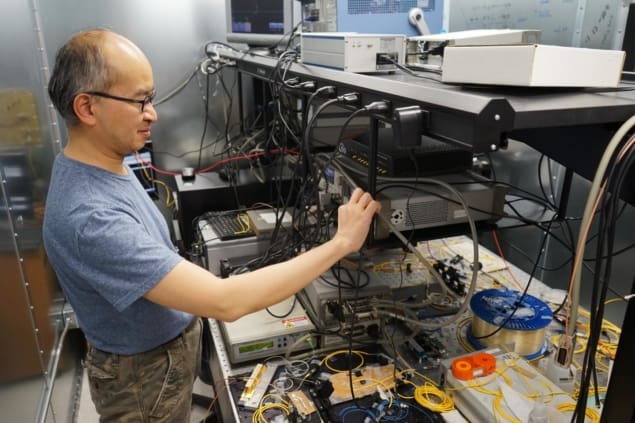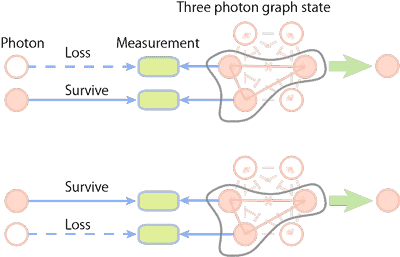
The goal of a worldwide “quantum internet” could be one step closer thanks to new experiments by researchers in Japan and Canada who have made the first ever quantum repeaters that work using an all-photonic protocol. The scheme importantly allows for the time-reversed adaptive Bell measurement, which is a key component for all-photonic quantum repeaters. It is based on optical devices alone and does not require any quantum memories or quantum error correction.
The Internet as we know it was not designed to be secure, and hacking, break-ins and espionage are unfortunately par for the course today. A quantum internet would be much more secure – as well as being much faster – since it exploits key features of quantum physics such as quantum entanglement.
Entanglement and quantum memories
Entanglement is a unique feature of quantum mechanics and allows particles with two distinct quantum states to share a much closer relationship than classical physics allows. If two particles are entangled, then we can know the state of one particle by measuring the state of the other. The very act of measuring the state of a quantum system disturbs it, however, and a third-party eavesdropper would instantly create a detectable trace, thus preventing them from stealing any information – an ultra-secure technique known as quantum key distribution.
The quantum internet would allow us to securely exchange information represented by quantum superposition states stored in quantum memories, which are very different to the binary memory in conventional computers. Researchers have already made matter quantum memories based on an atomic ensemble, a single atom and an ion trap, to name but three examples.

Repeaters and quantum repeaters
The Internet relies on a global network of optical fibre cables. Since light signals lose their intensity as they travel long distances through these cables, devices called repeaters, which boost and amplify the signals, are inserted at regular intervals along the lines.
The quantum version of the Internet would work by replacing these repeaters with all-photonic quantum ones based only on optical devices, such as linear optical elements, single-photon sources and photon detectors. They are unlike the conventional quantum repeaters made so far that require both optical devices and matter quantum memories, but are difficult to make because they need to store a quantum state at the repeater sites, which also makes them much more error prone. They are also impractical at present and expensive since they often need to operate at cryogenic temperatures.
The all-photonic quantum repeater protocol was first put forward in 2015 by theorists Koji Azuma of the NTT Corporation, Kiyoshi Tamaki of the University of Toyama and Hoi-Kwong Lo of the University of Toronto.
The time-reversed adaptive Bell measurement
Researchers led by Takashi Yamamoto of Osaka University working with the above team have now put forward a way to overcome these problems and are reporting on the first experimental demonstration for a key component of the all-photonic quantum repeater – the time-reversed adaptive Bell measurement.

The quantum Y2K moment
“All quantum repeaters, be they standard ones or all-photonic, need to perform the adaptive Bell measurement,” explains Yamamoto. Unlike standard quantum repeaters that can retain the quantum states of photons in a material system until the measurement is made, all-photonic ones implement it in a time-reversed manner using quantum entanglement.
Proof-of-principle demonstration
“In our experiment, we prepared entangled single photons in a repeater node and confirmed that the device only teleports lossless quantum information without being disturbed by surrounding lost quantum information. This is not only the first proof-of-principle demonstration of the adaptive Bell measurement but also a key principle of all-photonic quantum repeaters.”
The researchers achieved their result by replacing the quantum memories in the repeater by a photonic graph state, which is an entangled state of three photons represented by a graph composed of nodes and edges. In this state, the nodes correspond to particles and edges connecting nodes represent the quantum entanglement between the corresponding particles.

Survived state is faithfully teleported
“For example, to efficiently perform quantum communication using an all-photonic quantum repeater located in the middle of an optical fibre linked to two users A and B, the users begin by generating quantum entanglement between their own quantum systems and photons,” explains Yamamoto. “They then send the photons through the fibre to the all-photonic quantum repeater, where the photonic graph state is generated. The state is measured using a photon interferometer.”
The team proved that its technique works by generating a three-photon graph state and detecting only photons that successfully survive their journey through the optical channels without any losses.

Next steps for quantum communication
Towards an all-optical quantum network
The all-photonic quantum repeater has many advantages over standard quantum repeaters, he tells Physics World. “For one, it could work at room temperature. Second, it does not need any quantum interface between photons and matter since it relies solely on optical devices. Finally, it is also extremely fast, working at light speeds, irrespective of communication distance, and consumes little power.”
The researchers, reporting their work in Nature Communications, say they now plan to develop large-scale graph-state photon generators and ultra-low loss photonic circuits that allow for the time-reversed adaptive Bell measurement on a large number of photons. “These circuits will enable us to scale up an all-optical quantum network,” says Yamamoto.



